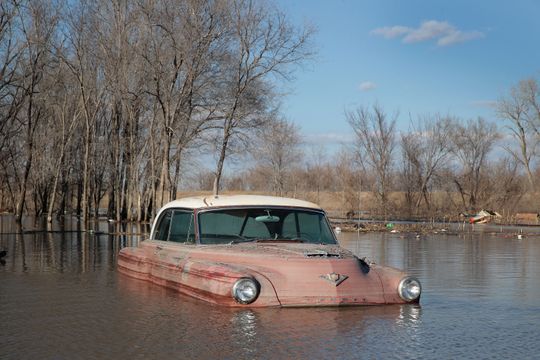Jacob Frey, Frank Klipsch and Sharon Weston Broome, Opinion contributors Published 6:00 a.m. ET April 11, 2019 | Updated 9:07 a.m. ET April 11, 2019
Our broken river infrastructure is no match for what scientists predict is the new normal. We should not have to depend on sandbags. Not in America.
Americans are now seeing the nightmare unfold that mayors throughout the Midwest have warned about for years.
Breached levees, flooded farms, washed out roads and drowned homes are disrupting lives, devastating communities, and straining state and city budgets. But the floods that made headlines and caught the attention of 2020 presidential campaigners are not the first and won’t be the last.
In the past 26 years, the Midwest has seen multiple 100-, 200- and 500-year flood events. The National Oceanic and Atmospheric Administration predicts that the flooding will get worse, bringing an “unprecedented” flood season to the heart of America. In fact, more flooding is expected in the coming days as a result of this week's giant spring snowstorm.
Midwesterners are used to intense storms, but this extreme weather overwhelmed us. Torrential rains throughout the region washed the deep layer of snow into the rivers, causing record-breaking river rise and catastrophic flooding starting upstream and rushing downstream on the region’s major waterways. Our river infrastructure is no match for what scientists predict is the new normal.
The damage is staggering. Iowa Gov. Kim Reynolds says the flooding has cost her state an estimated $1.6 billion and submerged at least 1,200 homes. Roughly 70 miles of levees operated by the U.S. Army Corps of Engineers are damaged or destroyed, and the cost to repair them is estimated at $350 million. An additional 175 miles of levees that are not federally owned and operated also need repairs costing roughly an additional $175 million.
Minnesota is facing a massive snowmelt, and Louisiana has been dealing with high water levels and the threat of floods since last November.
What does that mean? We are entering an unprecedented flooding season with an outdated and broken river infrastructure. Absent the necessary systemic solutions and support, we are left to pile sandbags around our homes, along our roads and around military bases, and hope for the best. Sandbags should not be our only option. Not in America. Not when we already know what we need to do to prepare and protect our communities.
Climate disasters require national response
As leaders of the Mississippi River Cities and Towns Initiative, we work alongside 85 other mayors from 10 states bordering the Mississippi River to grapple with the environmental challenges facing the region. We understand the need for systemic solutions to climate challenges. When it comes to the environment and the critical national asset that is the Mississippi River, we are all in it together.
For the past seven years, the mayors have presented to Congress and federal agencies a unified infrastructure and investment plan to address the region’s growing vulnerability to disasters. Each year, our plan has become more advanced, highlighting new and innovative partners across the globe. But the sheer scale of the challenges we face can only be met through bold congressional action like a comprehensive infrastructure bill. An infrastructure package that includes transformative proposals like a resilience revolving loan fund and projects such as natural infrastructure restoration, sustainability, resilience and climate risk mitigation is critical.
Our work with the Mississippi River Caucus in the U.S. House and Senate has yielded progress. But it will take the will of a nation to meet the problems at the scale we face today — the wildfires of the West and floods of the central United States are prime examples that this is a national challenge.
The current administration proposed a budget that would set us back. It contains deep cuts to the Army Corps of Engineers, whose public servants maintain much of the levee system that we still rely on. The budget also threatens to deplete funding for critical domestic programs that cities along the Mississippi need.
Rebuild old infrastructure for new reality
It would be easy to forget about the damage here once the headlines move on to the next crisis. But ignore the Midwest at your own peril. The Mississippi River and its tributaries span 31 states, covering 41% of the nation and supporting one of the most agriculturally productive regions on the planet.
The river is the linchpin of the nation’s domestic freight and water infrastructure, transporting 40% of the nation’s agricultural output, creating nearly $500 billion in annual revenue and directly supporting more than 1.5 million jobs. If we don’t invest in maintaining our nation’s busiest waterway, the losses will ripple throughout the country.
Mayors don’t have the luxury of distance and denial. We can’t complain about gridlock or blame the opposition. We have little time for grandstanding. We live in our communities, and we feel the consequences of our decisions. When it comes to tackling the immense challenge of rebuilding old infrastructure for a new climate reality, it’s long past time that Washington take some direction from leaders on the front lines.
Jacob Frey is the mayor of Minneapolis and a member of the Mississippi River Cities and Towns Initiative. Frank Klipsch is the mayor of Davenport, Iowa, and a co-chair of MRCTI. Sharon Weston Broome is the mayor of Baton Rouge, Louisiana, and serves on the MRCTI Executive Committee. Follow them on Twitter: @Jacob_Frey, @KlipschForMayor and @MayorBroome

